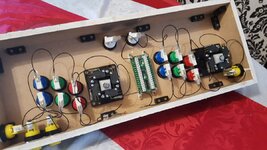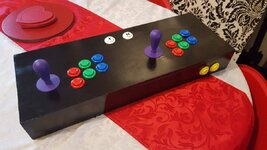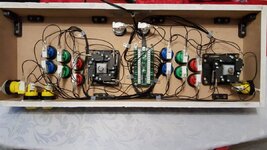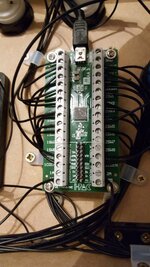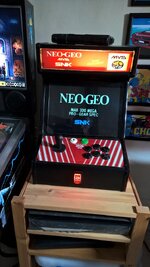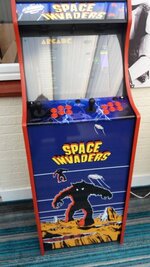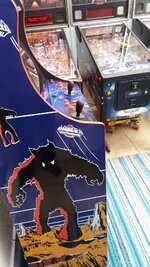As well as Pinball i've also always been a huge fan of all forms of retro gaming, but particularly MAME. It's a simply incredible piece of software which allows you to play many of the old classics at home but for me the big problem has always been that it's just not the same playing them without the authentic controls.
Anyway, a few weeks back I decided to take the plunge and buy some components to put together a two player arcade stick. The longer term goal is probably to build a Bartop Arcade or maybe even a full size cab but right now both space and funds are limited and what money I do have it generally being spent on getting Rocky & Bullwinkle back to working order. However, an Arcade Stick project seemed like a good option as it'd give me the chance to get a bit more of a handle on how it all works and how to put things together.
So this thread is just really an overview of what i've done and how.
For starters I grabbed a full kit from Arcade World UK. This included two Il Euro Joysticks and a shedload of buttons. You can specify what colours you want but I got a mixture of red, yellow, blue and green. With hindsight I could have done with some other colours too but it's not too much of an issue to order some extras and swap them out later if necessary.
Also included was a ground wiring harness, 32 crimped wires to the button signals and an I-Pac 2 that will drive everything. This was the thing I ordered and it came in at around £100.
But before we can do anything I needed something into which I could actually fit everything. Being the impatient sod that I am I decided to start off with a prototype made of just a single sheet of MDF and some holes drilled into it. This was partly so I could try it out, but also so I could make sure button positions were correct. The layout itself was actually downloaded and printed from here
For the sake of testing I sacrificed two of the fire buttons to other functions. It was a useful exercise as it identified that the joystick was a little too far to the left and might foul the side of the chassis, hence why i've scrawled an arrow with 1cm against it.
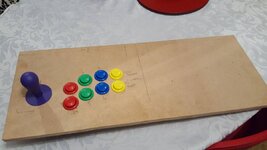
And the back. I've used the feet provided with the I-PAC to mount it on the controller. Wiring everything up was a doddle. The ground wiring harness (the bundle tie-wrapped up below the I-PAC) is interconnected with spade connectors so it's just a simple case of hooking up one of those to each COM terminal on the joystick and button switches. Then you take one of the signal wires, strip the sheathing back and connect that to the appropriate screw terminal on the I-PAC. Finally hook the spade connector on the other end up to the signal terminal on the appropriate switch and that's it.
In terms of software configuration it's pretty much plug and play. There is an application you can download though if you want to modify the configuration so different buttons have different functions.
One cool thing is that you can have 'SHIFTED' buttons. That means you can hold down one button (for example, Player 1 Start) and then the other buttons you press have different actions. Handy for when you're in the menus and want to start a specific game, or if you wish to exit the game you're currently playing. In theory it means you can run the whole lot without ever needing to connect a keyboard to the PC.
In my case i'll be adding some extra buttons for P1 and P2 start and then a few more for things like P1 Coin Insert and Exit Game.
Of course the final wiring will be much tidier as i'll clip the cables to length.
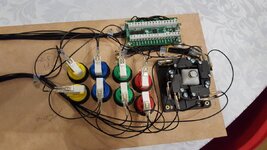
With this done the next job was to actually make a start on the controller. Now my woodworking skills are far from good so I needed to come up with some way to make a box around 60cm wide. I did a bit of digging around and decided to make the box from 12mm MDF along with some block connectors (not sure what the proper name for them is). I'm sure anyone who does joinery or who is skilled at woodwork will be shuddering at this point. ;-)
To make matters worse I have limited tools as well so all cuts had to be done with a jigsaw which, as most people know, means it's almost impossible to get a totally straight cut. Undeterred I continued anyway. This was about gaming and so long as it was sturdy and didn't crumble under play I wasn't too fussed; and after all it's MDF which is cheap and if i'm not happy with it then there's nothing to stop me going ahead and trying for 'v2' of the controller ;-)
Here you can see the interior of the controller. The exterior is white because i've used a gloss roller to apply some MDF primer. I'd read online that untreated MDF will gobble up the paint and most likely swell so I figured priming it was a good idea. Prior to this i'd also applied some wood filler to tidy up some of the terrible mistakes made due to my non-l33t wood-working skills. After that I sanded it down with a ROS.
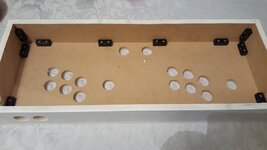
And here's the exterior. Looks good enough for me.
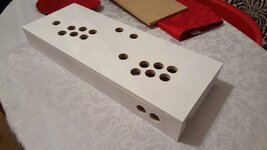
Finally I used to black gloss spray to cover the whole thing. Now I have to hold my hand up here and say that I think I did a terrible job of priming the MDF because once i'd applied the black spray it didn't look great. A combination the priming not being great and me not quite sanding down the filler enough means there are some noticeable blemishes on the finished article; that said it's sturdy enough and should work just fine.
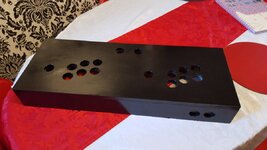
So, i'm pretty much at the point now where I can start fitting buttons and stuff. Then it's onto wiring everything up.
Oh, and at the moment i've not yet decided how i'm going to cover the bottom of this. The MDF is only 12mm thick so screwing into it is a no-no as it'll just split. Need to give that some thought.
Anyway, a few weeks back I decided to take the plunge and buy some components to put together a two player arcade stick. The longer term goal is probably to build a Bartop Arcade or maybe even a full size cab but right now both space and funds are limited and what money I do have it generally being spent on getting Rocky & Bullwinkle back to working order. However, an Arcade Stick project seemed like a good option as it'd give me the chance to get a bit more of a handle on how it all works and how to put things together.
So this thread is just really an overview of what i've done and how.
For starters I grabbed a full kit from Arcade World UK. This included two Il Euro Joysticks and a shedload of buttons. You can specify what colours you want but I got a mixture of red, yellow, blue and green. With hindsight I could have done with some other colours too but it's not too much of an issue to order some extras and swap them out later if necessary.
Also included was a ground wiring harness, 32 crimped wires to the button signals and an I-Pac 2 that will drive everything. This was the thing I ordered and it came in at around £100.
But before we can do anything I needed something into which I could actually fit everything. Being the impatient sod that I am I decided to start off with a prototype made of just a single sheet of MDF and some holes drilled into it. This was partly so I could try it out, but also so I could make sure button positions were correct. The layout itself was actually downloaded and printed from here
For the sake of testing I sacrificed two of the fire buttons to other functions. It was a useful exercise as it identified that the joystick was a little too far to the left and might foul the side of the chassis, hence why i've scrawled an arrow with 1cm against it.

And the back. I've used the feet provided with the I-PAC to mount it on the controller. Wiring everything up was a doddle. The ground wiring harness (the bundle tie-wrapped up below the I-PAC) is interconnected with spade connectors so it's just a simple case of hooking up one of those to each COM terminal on the joystick and button switches. Then you take one of the signal wires, strip the sheathing back and connect that to the appropriate screw terminal on the I-PAC. Finally hook the spade connector on the other end up to the signal terminal on the appropriate switch and that's it.
In terms of software configuration it's pretty much plug and play. There is an application you can download though if you want to modify the configuration so different buttons have different functions.
One cool thing is that you can have 'SHIFTED' buttons. That means you can hold down one button (for example, Player 1 Start) and then the other buttons you press have different actions. Handy for when you're in the menus and want to start a specific game, or if you wish to exit the game you're currently playing. In theory it means you can run the whole lot without ever needing to connect a keyboard to the PC.
In my case i'll be adding some extra buttons for P1 and P2 start and then a few more for things like P1 Coin Insert and Exit Game.
Of course the final wiring will be much tidier as i'll clip the cables to length.

With this done the next job was to actually make a start on the controller. Now my woodworking skills are far from good so I needed to come up with some way to make a box around 60cm wide. I did a bit of digging around and decided to make the box from 12mm MDF along with some block connectors (not sure what the proper name for them is). I'm sure anyone who does joinery or who is skilled at woodwork will be shuddering at this point. ;-)
To make matters worse I have limited tools as well so all cuts had to be done with a jigsaw which, as most people know, means it's almost impossible to get a totally straight cut. Undeterred I continued anyway. This was about gaming and so long as it was sturdy and didn't crumble under play I wasn't too fussed; and after all it's MDF which is cheap and if i'm not happy with it then there's nothing to stop me going ahead and trying for 'v2' of the controller ;-)
Here you can see the interior of the controller. The exterior is white because i've used a gloss roller to apply some MDF primer. I'd read online that untreated MDF will gobble up the paint and most likely swell so I figured priming it was a good idea. Prior to this i'd also applied some wood filler to tidy up some of the terrible mistakes made due to my non-l33t wood-working skills. After that I sanded it down with a ROS.

And here's the exterior. Looks good enough for me.

Finally I used to black gloss spray to cover the whole thing. Now I have to hold my hand up here and say that I think I did a terrible job of priming the MDF because once i'd applied the black spray it didn't look great. A combination the priming not being great and me not quite sanding down the filler enough means there are some noticeable blemishes on the finished article; that said it's sturdy enough and should work just fine.

So, i'm pretty much at the point now where I can start fitting buttons and stuff. Then it's onto wiring everything up.
Oh, and at the moment i've not yet decided how i'm going to cover the bottom of this. The MDF is only 12mm thick so screwing into it is a no-no as it'll just split. Need to give that some thought.

